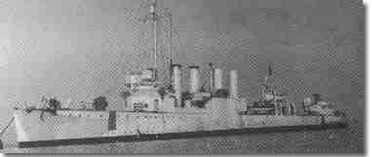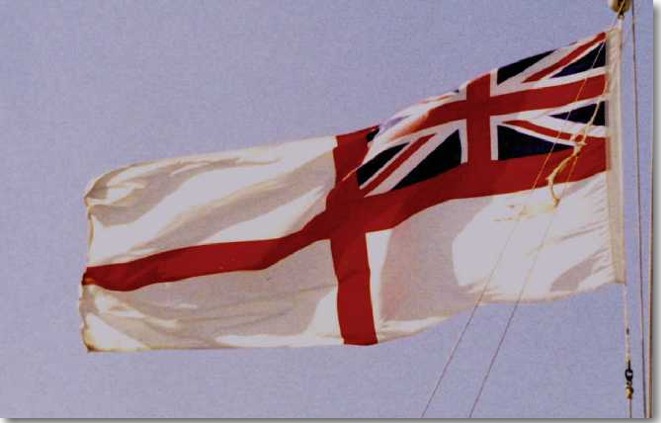|
Town Destroyer: HMS Mansfield ex USS Evans
 | Introduction
In the early stages of WW2, the Royal Navy in particular, and Britain in general, were faced with coping with the incredible toll taken by German U-Boats in the Battle of the Atlantic.
Anti- Submarine escort ships of the RN were in short supply, they were desperately needed to escort the convoys carrying vital supplies from North America to Britain.
Winston Churchill and President Franklin Roosevelt, in 1940, struck a deal under the US Lend Lease Act whereby, 50 old US WW1 Destroyers, which had been part of the US moth ball Fleet since the 1920's, were to be handed over to Britain, in exchange for 99 year leases on bases in the Western Hemisphere.
The Leased Sites
America struck a hard bargain in this deal.
Britain granted these long leases which allowed the US to build bases on: Antigua, British Guiana, Jamacia, St Lucia, Bermuda, Trinidad, and Newfoundland.
50 Destroyers of the Clemson Class
These old Destroyers were all flush deckers, they had four funnels, and no one could say they were a pretty sight.
Eight went off to the Royal Canadian Navy, but all of them needed extensive refits if they were to cope with Atlantic Ocean conditions.
They has a huge turning circle, and very narrow sterns which put the propellors at risk when coming alongside a pier or wharf.
In any sort of sea they reportedly rolled alarmingly, and the US Navy warned the British that, as the oil fuel was used up, it was wise to refill the empty oil tanks with sea water to stop the possibility of a ship capsizing. This was an unusual practice for the Royal Navy, who did not take kindly to the possible contamination of salt water in the oil fuel.
This class of ship may best be described as similiar in age, size and armament with the British WW1 V & W Class Destroyers. The Royal Australian Navy had HMAS Vampire, HMAS Waterhen etc in this Class of ship, and they were part of the so called Scrap Iron Flotilla, that served with great distinction in the Mediterranean in WW2, they kept besieged Tobruk alive, by often completing the Spud Run.
By 1943, the use made of most of these old ships had been downgraded, the need for them had passed.
Eight went off to Russia, with French, Norwegian and Polish sailors manning others. The US Navy still had another 80 of this Class of Destroyer, although they were in much better shape than those traded to Britain.
U-Boats versus Town Class Destroyers
In this battle, the U-Boats had the better of the old Destroyers.
They managed to sink 7 of them:
| Town Destroyer |
U-Boat Sinking the Town |
Date Sunk |
| HMS Bath |
U-204 |
19 August 1941. |
| HMS Broadwater |
U-101 |
18 October 1941. |
| HMS Stanley |
U-574 |
19 December 1941. |
| HMS Belmont |
U-82 |
31 January 1942. |
| HMS Beverley |
U-188 |
11 April 1943. |
| HMCS St Croix |
U-305 |
20 September 1943. |
| HMS Churchill * |
U-956 |
16 January 1945. |
| * Loaned to Soviet Navy in 1944, renamed Dyatelni, and sunk in the Arctic. |
The flip side of the battle with the U-Boats
The Town Class Destroyers accounted for four U-Boats: U-90, U-110, U-187, and U-207, whilst U-570 was captured.
Typical Statistics of these Destroyers
Standard Displacement. 1,020, and 1,190 tons.
Length. 314 feet.
Beam. 31 feet 8 inches.
Draught. 12 feet 10 inches.
Armament
4 by 4 inch guns
1 by 3 inch gun
21 inch Torpedoes
4 by triple Torpedo Tubes
Depth Charge Throwers.
Speed. 27.5 knots.
Complement. Approximately 190.
Built. Between 1916 - 1919.
Ship Names
When transferring to the Royal Navy, the names of all these 50 ships were all changed to place names of towns ( hence the ships were known as Town Class ) that were common to both countries, eg.
| US ship name |
British ship name |
| USS MacKenzie* |
HMCS Annapolis |
| USS Hopewell |
HMS Bath |
| USS McClanehan |
HMS Bradford |
| USS Mason |
HMS Broadwater |
| USS Welles |
HMS Cameron |
| USS Harndon |
HMS Churchill |
| * Note: I just had to include my namesake, MacKenzie. |
Conclusion
At the time when Britain was in dire need of additional Escort vessels, these 50 ships filled the void, although they took some time to be refitted up to an acceptable operational level to get into useful service.
Britain paid a heavy price for these ships, undoubtedly, it was the United States that reaped the greater reward from this deal, than did Britain.
The British White Ensign worn by all the Town Class Destroyers after transferring to the Royal Navy
 |
|